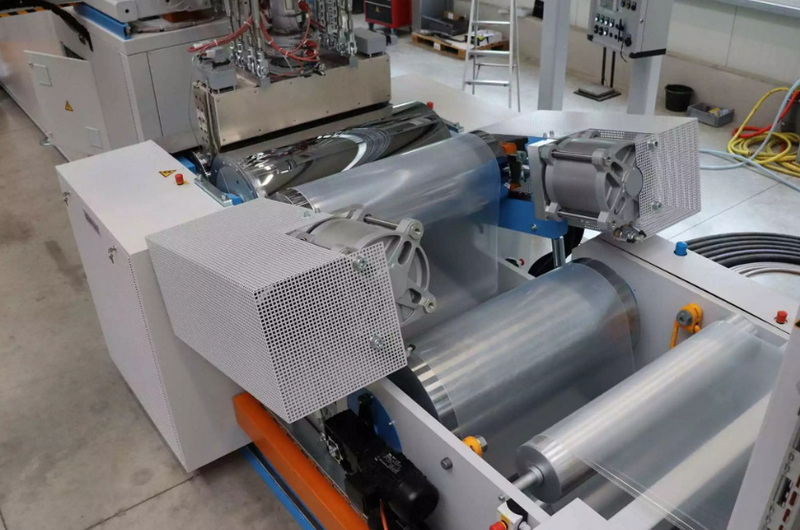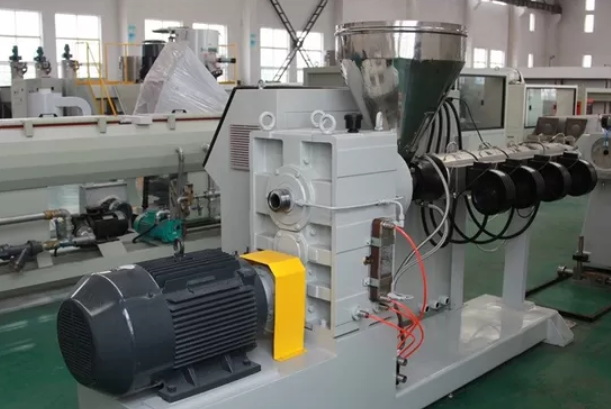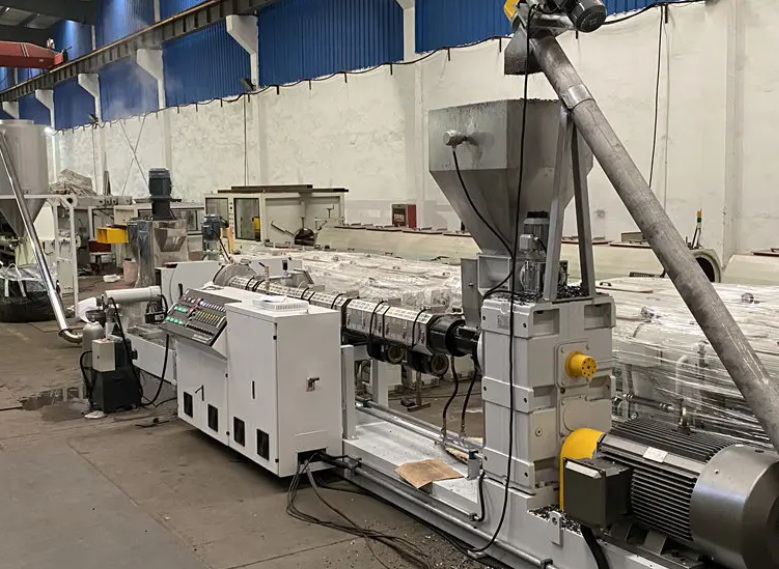Content Menu
● Introduction to Plastic Polymer Extrusion Machinery
● The Plastic Extrusion Process: Step by Step
>> 1. Raw Material Preparation
>> 2. Feeding
>> 3. Melting and Plastication
>> 4. Mixing and Homogenization
>> 5. Filtration
>> 6. Shaping (Forming)
>> 7. Cooling
>> 8. Pulling and Cutting
● Key Components of Plastic Polymer Extrusion Machinery
● Types of Plastic Polymer Extrusion Machinery
>> Single-Screw Extruders
>> Twin-Screw Extruders
>> Ram Extruders
>> Specialized Extruders
● Applications of Plastic Polymer Extrusion Machinery
● Advancements and Trends in Plastic Extrusion Technology
>> Smart Extrusion Machinery
>> Multi-Layer Extrusion
>> Advanced Materials
>> Energy Efficiency
● Troubleshooting and Quality Control in Plastic Extrusion
● Factors Affecting Productivity and Efficiency
● Conclusion
● FAQ
>> 1. What types of plastic materials can be processed using plastic polymer extrusion machinery?
>> 2. What is the difference between single-screw and twin-screw extrusion machines?
>> 3. How is the shape of the extruded plastic determined?
>> 4. What are common defects in plastic extrusion and how are they addressed?
>> 5. How can manufacturers optimize productivity with plastic polymer extrusion machinery?
● Citations:
Plastic polymer extrusion machinery stands as a cornerstone of modern manufacturing, enabling the efficient, continuous production of countless plastic products that shape our daily lives. From packaging films and pipes to automotive parts and construction profiles, the versatility and reliability of plastic polymer extrusion machinery have made it indispensable across industries. This article provides an in-depth exploration of what plastic polymer extrusion machinery is, how it operates, the types available, its applications, and the latest advancements in the field.

Introduction to Plastic Polymer Extrusion Machinery
Plastic polymer extrusion machinery is a specialized set of equipment designed to transform raw plastic materials—usually in the form of pellets or granules—into continuous profiles with a fixed cross-sectional shape. This is achieved by melting the polymer and forcing it through a shaped die, after which the extruded product is cooled and cut to the desired length. The process is highly adaptable, supporting the production of a vast array of items, from simple tubing to complex multi-layered films[5][16][19].
The significance of plastic polymer extrusion machinery lies in its ability to produce high volumes of consistent, customizable products at relatively low cost and with minimal waste. Its continuous operation and adaptability to different polymers and additives make it a preferred choice for manufacturers worldwide[5][19].
The Plastic Extrusion Process: Step by Step
Understanding how plastic polymer extrusion machinery works requires a look at the sequential steps that convert raw plastic into finished products:
1. Raw Material Preparation
The process begins with the selection and preparation of the polymer resin. Additives such as colorants, UV stabilizers, flame retardants, and fillers may be mixed with the base resin to achieve specific properties[1][10][15]. Proper drying of the material is essential to prevent defects like bubbles or poor surface finish[10].
2. Feeding
The prepared plastic material is loaded into a hopper, which feeds the material into the extruder barrel. Consistent feeding is crucial for uniform output and quality[2][10][12].
3. Melting and Plastication
Inside the heated barrel, a rotating screw conveys the plastic material forward. The combination of external heaters and frictional heat generated by the screw melts the polymer, transforming it into a homogeneous, viscous liquid[1][5][10].
4. Mixing and Homogenization
The screw design ensures thorough mixing of the molten plastic, dispersing additives evenly and eliminating unmelted particles or contaminants[1][10].
5. Filtration
Before reaching the die, the molten plastic passes through a screen pack and breaker plate. This step removes any remaining impurities and ensures a uniform melt, maintaining pressure and preventing die blockages[2][5][15].
6. Shaping (Forming)
The filtered, molten polymer is forced through a die, which imparts the desired cross-sectional profile to the extrudate. The die's design is critical, as it directly determines the shape and dimensions of the final product[1][5][8].
7. Cooling
Upon exiting the die, the hot extrudate is rapidly cooled—typically using water baths, air, or cooling rolls—to solidify its shape and prevent deformation[1][10][8].
8. Pulling and Cutting
A haul-off or pulling system maintains consistent tension and speed, ensuring uniform product thickness. The continuous profile is then cut to the required length or wound onto spools for further processing[10].
Key Components of Plastic Polymer Extrusion Machinery
Plastic polymer extrusion machinery is composed of several integral components, each playing a vital role in the process[2][6][12]:
| Component | Function |
| Hopper | Stores and feeds raw plastic material into the extruder |
| Feed Throat | Transfers material from the hopper to the barrel |
| Barrel | Houses the screw and provides the heating environment |
| Screw | Rotates to convey, melt, and mix the plastic material |
| Heaters | Maintain the necessary temperature profile along the barrel |
| Breaker Plate & Screen Pack | Filter contaminants and maintain pressure |
| Die | Shapes the molten plastic into the desired profile |
| Cooling System | Solidifies the extrudate by rapid cooling |
| Puller/Haul-off | Maintains product speed and tension |
| Cutter | Cuts the continuous profile into specified lengths |
Each component must be precisely engineered and maintained to ensure consistent, high-quality output[2][6][12].
Types of Plastic Polymer Extrusion Machinery
Plastic polymer extrusion machinery comes in various configurations, each suited to specific materials and applications[4][6][14][16]:
Single-Screw Extruders
- Description: Most common type; features a single rotating screw in the barrel.
- Applications: General-purpose extrusion (pipes, sheets, films, profiles).
- Advantages: Simple design, cost-effective, easy to operate and maintain.
- Limitations: Limited mixing capability, less suitable for complex compounding[4][14][16].
Twin-Screw Extruders
- Description: Features two intermeshing or parallel screws, which may rotate in the same or opposite directions.
- Applications: Compounding, blending, processing of heat-sensitive or filled polymers.
- Advantages: Superior mixing, better heat transfer, enhanced control over the melting process.
- Limitations: More complex, higher cost, requires skilled operation[4][6][14][16].
Ram Extruders
- Description: Uses a ram or plunger instead of a screw to push the material.
- Applications: Less common; used for specific materials or shapes.
- Advantages: Suitable for high-viscosity or special polymers.
- Limitations: Lower throughput, less versatility[14].
Specialized Extruders
- PVC Extruders: Designed for precise temperature control to handle PVC's sensitivity to heat.
- HDPE and PET Extruders: Engineered to accommodate higher melting points and specific material properties[6].

Applications of Plastic Polymer Extrusion Machinery
Plastic polymer extrusion machinery is used to manufacture a vast array of products across multiple industries[13][19]:
| Industry | Typical Extruded Products |
| Packaging | Films, sheets, bags, containers |
| Construction | Pipes, window frames, siding, insulation profiles |
| Automotive | Weather seals, trim, tubing, wire insulation |
| Medical | Tubing, catheters, device components |
| Electronics | Cable jacketing, insulation |
| Consumer Goods | Toys, sporting goods, furniture components |
| Solar & Renewable | Panel frames, encapsulation materials |
The adaptability of plastic polymer extrusion machinery allows for the production of both simple and highly complex profiles, meeting diverse market demands[13][19].
Advancements and Trends in Plastic Extrusion Technology
The field of plastic polymer extrusion machinery continues to evolve, driven by technological innovation and market demands[8][19]:
Smart Extrusion Machinery
- Integration of IoT and Sensors: Real-time monitoring and control of process parameters for improved consistency and reduced downtime.
- Predictive Maintenance: Data analytics to anticipate equipment failures and schedule maintenance proactively[19].
Multi-Layer Extrusion
- Co-Extrusion: Production of multi-layer films and sheets with tailored properties (e.g., barrier layers for packaging).
- Benefits: Enhanced product performance, reduced material usage, expanded application possibilities[19].
Advanced Materials
- High-Performance Polymers: Use of engineered plastics and composites for lightweight, durable, and heat-resistant products.
- Bioplastics: Growing adoption of renewable, biodegradable materials in response to sustainability trends[19].
Energy Efficiency
- Variable Speed Drives: Reduce energy consumption and optimize performance.
- Efficient Heating Systems: Minimize heat loss and operational costs[19].
Troubleshooting and Quality Control in Plastic Extrusion
Consistent quality is essential in plastic extrusion. Common issues and their solutions include[7][18]:
| Problem | Possible Causes & Solutions |
| Interrupted Melt Output | Check barrel temperatures, screen for blockages, adjust feed zone |
| Surging/Uneven Flow | Adjust temperatures, clean screens, check screw design |
| No Output | Inspect hopper, increase die temperature, clear blockages |
| Rough Surface | Increase compression zone temperature, inspect screen for tears |
| Burned/Discolored Output | Reduce screw speed, lower barrel temperature |
| Die Lines, Melt Fracture | Adjust die temperature, select appropriate material |
| Bubbles, Warpage | Ensure material is dry, optimize cooling system |
Quality control involves regular inspection of raw materials, monitoring process parameters, and checking final product dimensions and properties against standards. Tools such as calipers, spectrophotometers, and automated monitoring systems are commonly used for this purpose[6][7][18].
Factors Affecting Productivity and Efficiency
Maximizing the efficiency of plastic polymer extrusion machinery requires careful attention to several factors[20]:
- Temperature Control: Precise management of barrel and die temperatures is crucial for consistent melting and flow[20].
- Machine Speed and Feed Rate: Balancing throughput with melt quality to avoid blockages or defects[20].
- Die Design and Maintenance: Well-designed, regularly maintained dies ensure uniform flow and product quality[20].
- Operator Training: Skilled operators can quickly identify and resolve issues, minimizing downtime[20].
- Material Selection: Using compatible polymers and additives enhances process stability and output[20].
Implementing regular maintenance, process optimization, and continuous training are best practices for sustaining high productivity and product quality[20].
Conclusion
Plastic polymer extrusion machinery is a foundational technology in the plastics industry, enabling the mass production of a diverse range of products with remarkable efficiency and consistency. By understanding the machinery's components, operation, and the nuances of the extrusion process, manufacturers can optimize their operations, enhance product quality, and adapt to evolving market demands. Ongoing advancements in automation, materials, and process control continue to expand the capabilities of plastic polymer extrusion machinery, ensuring its relevance and value for years to come.

FAQ
1. What types of plastic materials can be processed using plastic polymer extrusion machinery?
Plastic polymer extrusion machinery can process a wide variety of thermoplastics, including polyethylene (PE), polypropylene (PP), polyvinyl chloride (PVC), polystyrene (PS), acrylonitrile butadiene styrene (ABS), and more. The choice of material depends on the desired product properties and application[4][12].
2. What is the difference between single-screw and twin-screw extrusion machines?
Single-screw extruders use one rotating screw and are ideal for straightforward extrusion tasks, offering simplicity and cost-effectiveness. Twin-screw extruders use two screws, providing superior mixing and compounding capabilities, making them suitable for complex formulations and heat-sensitive materials[4][6][14].
3. How is the shape of the extruded plastic determined?
The shape of the extruded plastic is determined by the die attached to the end of the extruder. The die is custom-designed to impart the required cross-sectional profile to the molten plastic as it exits the machine[1][5][8].
4. What are common defects in plastic extrusion and how are they addressed?
Common defects include surging, rough surfaces, bubbles, warpage, and discoloration. These issues can often be resolved by adjusting temperatures, ensuring proper material drying, cleaning screens, and maintaining optimal screw speed and die conditions[7][18].
5. How can manufacturers optimize productivity with plastic polymer extrusion machinery?
Manufacturers can boost productivity by maintaining precise temperature control, optimizing machine speed and feed rates, regularly servicing dies and equipment, training operators, and selecting appropriate materials for specific applications[20].
Citations:
[1] https://waykenrm.com/blogs/plastic-extrusion-process/
[2] https://www.fictiv.com/articles/plastic-extrusion-explained
[3] https://plasticextrusiontech.net/machines-used-in-the-plastic-extrusion-process/
[4] https://www.cnchaoxu.com/news-center/what-are-the-different-types-of-plastic-extrusion-machines
[5] https://www.twi-global.com/technical-knowledge/faqs/plastic-extrusion
[6] https://jieyatwinscrew.com/blog/everything-you-need-to-know-about-plastic-extrusion-machines/
[7] https://www.elastron.com/en/12-extrusion-defects-and-troubleshooting-elastron-tpe
[8] https://www.jwellmachine.com/analysis-of-plastic-extrusion-technology/
[9] https://www.siliconeplastics.com/post/enhancing-product-design-with-plastic-extrusion-tips-and-techniques-for-manufacturers
[10] https://www.3devo.com/plastic-extrusion
[11] https://www.jwellextrusions.com/introduction-to-the-working-principle-of-sheet-extruder-machine.html
[12] https://paulmurphyplastics.com/industry-news-blog/understanding-plastic-extrusion-2/
[13] https://www.clarkrandp.com/6-common-applications-of-plastic-extrusion/
[14] https://apenergy.com/blogs/the-ultimate-guide-to-plastic-extrusion-machines/
[15] https://ptfe-machinery.com/plastic-extrusion-basic-information-supplies-process-design/
[16] https://blog.goldsupplier.com/plastic-extrusion-machines/
[17] https://stacindustry.com/en/processes/main/polymer-extrusion/
[18] https://www.plasticsengineering.org/2024/05/extrusion-troubleshooting-key-drivers-part-1-of-3-004709/
[19] https://abhiplastics.com/revolutionizing-the-plastic-industry-how-plastic-extrusion-machinery-is-changing-the-game/
[20] https://abhiplastics.com/the-ultimate-guide-to-boosting-productivity-with-plastic-extrusion-machines/
[21] https://jfextruder.com/what-is-a-plastic-extruder-machine/
[22] https://plastic-extrusionmachines.com/plastic-extrusion-machine-work/
[23] https://jieyatwinscrew.com/blog/polymer-extrusion/
[24] https://www.ptonline.com/articles/extrusion-troubleshooter
[25] https://jieyatwinscrew.com/blog/the-ultimate-guide-to-plastic-extruder-machines/
[26] https://plasticextrusiontech.net/benefits-of-plastic-extrusion/
[27] https://www.globenewswire.com/news-release/2025/01/01/3003246/0/en/Europe-Plastic-Extrusion-Machine-Market-Valuation-is-Skyrocketing-to-Reach-US-3-901-68-Million-by-2033-Astute-Analytica.html
[28] https://www.plasticstoday.com/plastics-processing/words-of-wisdom-the-10-11-key-principles-of-extrusion
[29] https://www.iqsdirectory.com/articles/plastic-extrusion.html
[30] https://www.beierextrusion.com/what-is-the-principle-of-the-extrusion-machine-and-the-structure-of-each-section/
[31] https://en.wikipedia.org/wiki/Plastic_extrusion
[32] https://stacindustry.com/en/processes/main/polymer-extrusion/
[33] https://www.jurryextrusion.com/info/basic-principles-of-plastic-extrusion-54081681.html
[34] https://plasticextrusiontech.net/machines-used-in-the-plastic-extrusion-process/
[35] https://www.extrusionscrews.com/PartsOfPlasticExtrusionMachines.php
[36] https://ptfe-machinery.com/plastic-extrusion-basic-information-supplies-process-design/
[37] https://ieda.ust.hk/dfaculty/ajay/courses/ieem215/lecs/6_plastics.pdf
[38] https://www.plastikcity.co.uk/blog/what-is-plastic-extrusion/
[39] https://www.3erp.com/blog/plastic-extrusion/






















